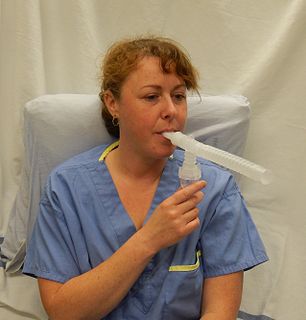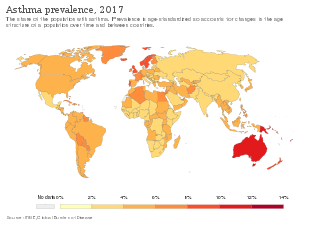Related Research Articles

Asthma is a long-term inflammatory disease of the airways of the lungs. It is characterized by variable and recurring symptoms, reversible airflow obstruction, and easily triggered bronchospasms. Symptoms include episodes of wheezing, coughing, chest tightness, and shortness of breath. These may occur a few times a day or a few times per week. Depending on the person, asthma symptoms may become worse at night or with exercise.
Diffusing capacity of the lung (DL) measures the transfer of gas from air in the lung, to the red blood cells in lung blood vessels. It is part of a comprehensive series of pulmonary function tests to determine the overall ability of the lung to transport gas into and out of the blood. DL, especially DLCO, is reduced in certain diseases of the lung and heart. DLCO measurement has been standardized according to a position paper by a task force of the European Respiratory and American Thoracic Societies.

The Buteyko method or Buteyko Breathing Technique is a form of complementary or alternative physical therapy that proposes the use of breathing exercises primarily as a treatment for asthma and other respiratory conditions. The therapy takes its name from Soviet doctor Konstantin Pavlovich Buteyko, who first formulated its principles during the 1950s.

In medicine, a nebulizer or nebuliser is a drug delivery device used to administer medication in the form of a mist inhaled into the lungs. Nebulizers are commonly used for the treatment of asthma, cystic fibrosis, COPD and other respiratory diseases or disorders. They use oxygen, compressed air or ultrasonic power to break up solutions and suspensions into small aerosol droplets that are inhaled from the mouthpiece of the device. An aerosol is a mixture of gas and solid or liquid particles.

Spirometry is the most common of the pulmonary function tests (PFTs). It measures lung function, specifically the amount (volume) and/or speed (flow) of air that can be inhaled and exhaled. Spirometry is helpful in assessing breathing patterns that identify conditions such as asthma, pulmonary fibrosis, cystic fibrosis, and COPD. It is also helpful as part of a system of health surveillance, in which breathing patterns are measured over time.

Bronchoconstriction is the constriction of the airways in the lungs due to the tightening of surrounding smooth muscle, with consequent coughing, wheezing, and shortness of breath.
DLCO or TLCO is the extent to which oxygen passes from the air sacs of the lungs into the blood. Commonly, it refers to the test used to determine this parameter. It was introduced in 1909.
A post-viral cough is a lingering cough that follows a viral respiratory tract infection, such as a common cold or flu and lasting up to eight weeks. Post-viral cough is a clinically recognized condition represented within the European medical literature. Patients usually experience repeated episodes of post-viral cough. The heightened sensitivity in the respiratory tract is demonstrated by inhalation cough challenge.
Occupational asthma is new onset asthma or the recurrence of previously quiescent asthma directly caused by exposure to an agent at workplace. It is an occupational lung disease and a type of work-related asthma. Agents that can induce occupational asthma can be grouped into sensitizers and irritants.
The specific inhalation challenge (SIC) is a diagnosis tool to assess airway responsiveness to "sensitizing" substances as opposed to nonspecific stimuli such as pharmacological agents, cold air and exercise. Subjects are exposed to a suspected occupational agent in a controlled way under close supervision in a hospital laboratory. The specific inhalation challenges has been considered as the gold standard in confirming the diagnosis of occupational asthma.
Malignant pleural effusion is a condition in which cancer causes an abnormal amount of fluid to collect between the thin layers of tissue (pleura) lining the outside of the lung and the wall of the chest cavity. Lung cancer and breast cancer account for about 50-65% of malignant pleural effusions. Other common causes include pleural mesothelioma and lymphoma.

Indacaterol is an ultra-long-acting beta-adrenoceptor agonist developed by Novartis. It needs to be taken only once a day, unlike the related drugs formoterol and salmeterol. It is licensed only for the treatment of chronic obstructive pulmonary disease (COPD). It is delivered as an aerosol formulation through a dry powder inhaler.
The pool chlorine hypothesis is the hypothesis that long-term attendance at indoor chlorinated swimming pools by children up to the age of about 6–7 years is a major factor in the rise of asthma in rich countries since the late twentieth century. A narrower version of the hypothesis, i.e. that asthma may be induced by chlorine related compounds from swimming pools, has been stated based on a small numbers of cases at least as early as 1995. An empirically motivated statement of the wider form of the hypothesis is first known to have been published on the basis of tests of the effects of nitrogen trichloride above chlorinated water on the lung as well as epidemiological evidence by a group of medical researchers led by Alfred Bernard of the Department of Public Health in the Catholic University of Louvain in Brussels, Belgium in 2003. In the epidemiological studies, the association between chlorinated swimming pools and asthma was found to be more significant than factors such as age, sex, ethnic origin, socioeconomic status, exposure to domestic animals and passive smoking, and independent of altitude, climate, and GDP per capita.
Pulmonary rehabilitation, also known as respiratory rehabilitation, is an important part of the management and health maintenance of people with chronic respiratory disease who remain symptomatic or continue to have decreased function despite standard medical treatment. It is a broad therapeutic concept. It is defined by the American Thoracic Society and the European Respiratory Society as an evidence-based, multidisciplinary, and comprehensive intervention for patients with chronic respiratory diseases who are symptomatic and often have decreased daily life activities. In general, pulmonary rehabilitation refers to a series of services that are administered to patients of respiratory disease and their families, typically to attempt to improve the quality of life for the patient. Pulmonary rehabilitation may be carried out in a variety of settings, depending on the patient's needs, and may or may not include pharmacologic intervention.
Ciclosporin is a cyclic polypeptide that has been used widely as an orally-available immunosuppressant. It was originally used to prevent transplant rejection of solid organs but has also found use as an orally administered agent to treat psoriasis, rheumatoid arthritis, dry eye and other auto-immune related conditions. A variety of pre-clinical and clinical studies have been and are investigating its use to treat lung-related disorders via inhalation.

As of 2011, circa 235 million people worldwide were affected by asthma, and approximately 250,000 people die per year from the disease. Low and middle income countries make up more than 80% of the mortality. Rates vary between countries with prevalences between 1 and 18%. It is more common in developed than developing countries. One thus sees lower rates in Asia, Eastern Europe and Africa. Within developed countries it is more common among those who are economically disadvantaged while in contrast in developing countries it is more common amongst the affluent. The reason for these differences is not well known.

Budesonide (BUD), sold under the brand name Pulmicort among others, is a medication of the corticosteroid type. It is available as an inhaler, pill, nasal spray, and rectal forms. The inhaled form is used in the long-term management of asthma and chronic obstructive pulmonary disease (COPD). The nasal spray is used for allergic rhinitis and nasal polyps. The pills in a delayed release form and rectal forms may be used for inflammatory bowel disease including Crohn's disease, ulcerative colitis, and microscopic colitis.
Salivary gland–like carcinomas of the lung generally refers a class of rare cancers that arise from the uncontrolled cell division (mitosis) of mutated cancer stem cells in lung tissue. They take their name partly from the appearance of their abnormal cells, whose structure and features closely resemble those of cancers that form in the major salivary glands of the head and neck. Carcinoma is a term for malignant neoplasms derived from cells of epithelial lineage, and/or that exhibit cytological or tissue architectural features characteristically found in epithelial cells.
Basaloid large cell carcinoma of the lung, is a rare histological variant of lung cancer featuring certain distinctive cytological, tissue architectural, and immunohistochemical characteristics and clinical behavior.

Pulmonary veno-occlusive disease (PVOD) is a rare form of pulmonary hypertension caused by progressive blockage of the small veins in the lungs. The blockage leads to high blood pressures in the arteries of the lungs, which, in turn, leads to heart failure. The disease is progressive and fatal, with median survival of about 2 years from the time of diagnosis to death. The definitive therapy is lung transplantation.
References
- ↑ "About Us". Global Initiative for Asthma. GINA. Archived from the original on 4 March 2016. Retrieved 7 February 2012.
- ↑ Bateman, E. D.; Hurd, S. S.; Barnes, P. J.; Bousquet, J.; Drazen, J. M.; Fitzgerald, M.; Gibson, P.; Ohta, K.; O'Byrne, P.; Pedersen, S. E.; Pizzichini, E.; Sullivan, S. D.; Wenzel, S. E.; Zar, H. J. (2008). "Global strategy for asthma management and prevention: GINA executive summary". European Respiratory Journal. 31 (1): 143–178. doi: 10.1183/09031936.00138707 . PMID 18166595.
- ↑ Boulet, LP; Fitzgerald JM; Levy ML; Cruz AA; Pedersen S; Haahtela T; Bateman ED. (1 May 2012). "Asthma guidelines implementation: a guide to the translation of GINA guidelines into improved care". Eur Respir J. 39 (5): 1220–9. doi: 10.1183/09031936.00184511 . PMID 22282546.
- ↑ Liard, R; Leynaert B; Zureik M; Beguin FX; Neukirch F. (16 October 2000). "Using Global Initiative for Asthma guidelines to assess asthma severity in populations". Eur Respir J. 16 (4): 615–20. doi: 10.1034/j.1399-3003.2000.16d08.x . PMID 11106201.